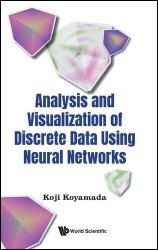Analysis and Visualization of Discrete Data Using Neural Networks
- Добавил: literator
- Дата: 3-02-2024, 05:36
- Комментариев: 0
 Название: Analysis and Visualization of Discrete Data Using Neural Networks
Название: Analysis and Visualization of Discrete Data Using Neural NetworksАвтор: Koji Koyamada
Издательство: World Scientific Publishing
Год: 2024
Страниц: 230
Язык: английский
Формат: pdf (true)
Размер: 53.9 MB
This book serves as a comprehensive step-by-step guide on data analysis and statistical analysis. It covers fundamental operations in Excel, such as table components, formula bar, and ribbon, and introduces visualization techniques and PDE derivation using Excel. It also provides an overview of Google Colab, including code and text cells, and explores visualization and Deep Learning applications.
Key features of the book include topics like statistical analysis, regression analysis, optimization, correlation analysis, and neural networks. It adopts a practical approach by providing examples and step-by-step instructions for learners to apply the techniques to real-world problems.
The book also highlights the strengths and features of both Excel and Google Colab, allowing learners to leverage the capabilities of each platform.
The clear explanations of concepts, visual aids, and code snippets aid comprehension help learners understand the principles of data analysis and statistical analysis. Overall, this book serves as a valuable resource for professionals, researchers, and students seeking to develop skills in data analysis, regression statistics, optimization, and advanced modeling techniques using Excel, Colab, and neural networks.
Google Colaboratory (Colab for short) is a free cloud service provided by Google, where you can use the Jupyter notebook and Python to analyze data and build a model for Machine Learning.
To conduct Deep Learning on Colab, you can perform the following steps:
1. Create a Colab notebook.
2. Install the libraries required for your notebook, such as TensorFlow and Keras.
3. Upload the data required for learning to Colab.
4. Build an NN used for learning.
5. Train the NN with learning data.
6. Make predictions using the trained model.
Colab has pre-installed libraries required for Deep Learning, such as TensorFlow and Keras, so Deep Learning can commence immediately just after importing the libraries. Colab also offers GPUs for free so that high-speed training using large amounts of data can be conducted. It is worth noting that Colab is a cloud service provided by Google; therefore, it must be utilized with connection to the Internet, and data storage is the user’s responsibility. Colab allows you to read data and perform statistical analysis by using Pandas and NumPy, Python’s libraries for data analysis. For example, you can use Pandas to read data from a CSV file and calculate the mean, standard deviation, minimum, and maximum values.
Скачать Analysis and Visualization of Discrete Data Using Neural Networks
Внимание
Уважаемый посетитель, Вы зашли на сайт как незарегистрированный пользователь.
Мы рекомендуем Вам зарегистрироваться либо войти на сайт под своим именем.
Уважаемый посетитель, Вы зашли на сайт как незарегистрированный пользователь.
Мы рекомендуем Вам зарегистрироваться либо войти на сайт под своим именем.
Информация
Посетители, находящиеся в группе Гости, не могут оставлять комментарии к данной публикации.
Посетители, находящиеся в группе Гости, не могут оставлять комментарии к данной публикации.
